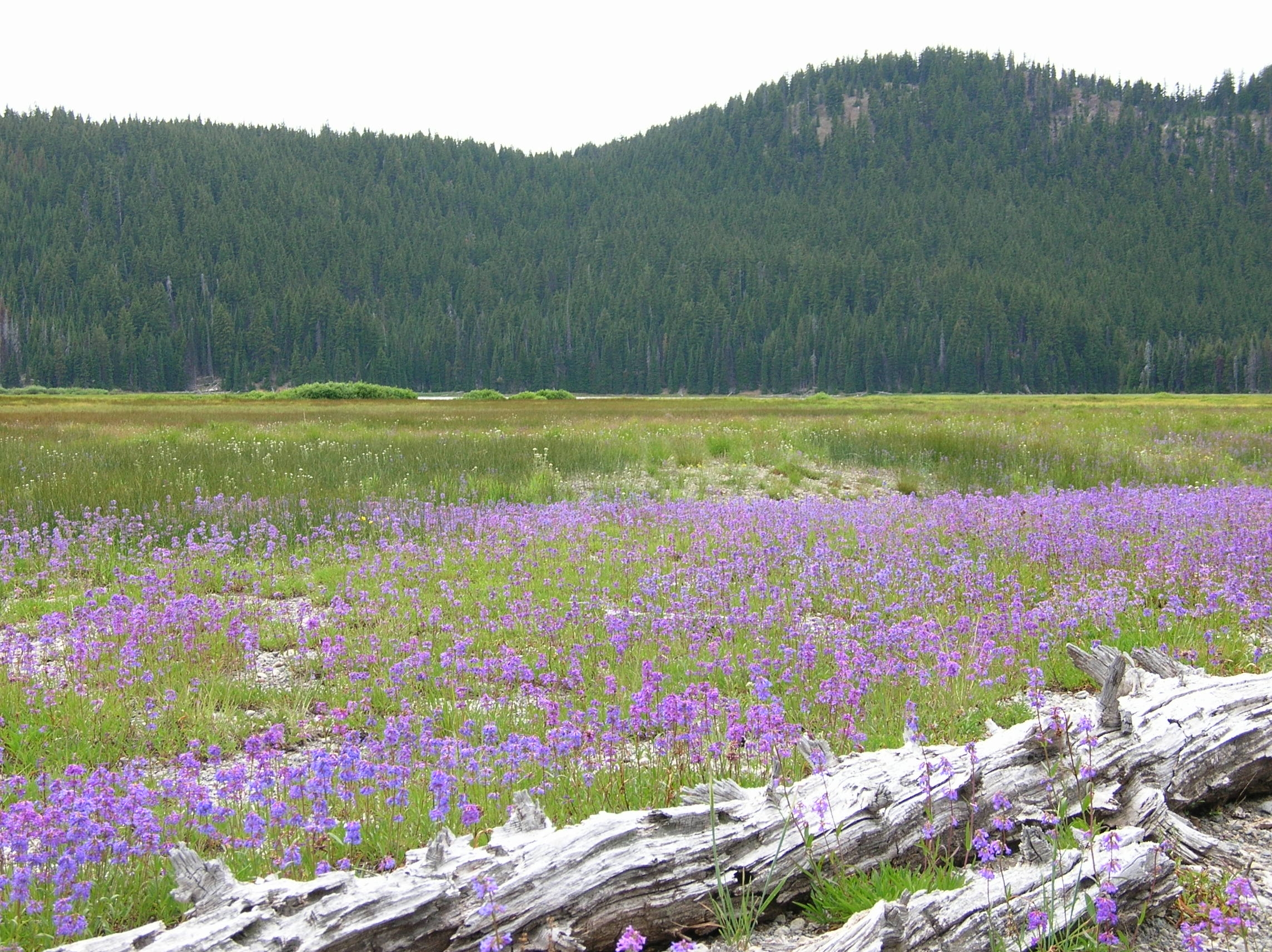|
Mount Bachelor
Mount Bachelor, formerly named Bachelor Butte, is a dormant stratovolcano atop a shield volcano in the Cascade Volcanic Arc and the Cascade Range of central Oregon. Named Mount Bachelor because it stands apart from the nearby Three Sisters, it lies in the eastern segment of the central portion of the High Cascades, the eastern segment of the Cascade Range. The volcano lies at the northern end of the long Mount Bachelor Volcanic Chain, which underwent four major eruptive episodes during the Pleistocene and the Holocene. The United States Geological Survey considers Mount Bachelor a moderate threat, but Bachelor poses little threat of becoming an active volcano in the near future. It remains unclear whether the volcano is extinct or just inactive. The Mount Bachelor ski area has operated on the mountain since 1958, and the volcano's summit hosts the Mount Bachelor Observatory. A center of winter recreation, the area offers snowshoeing, snow skiing, snow tubing, and dog sledding, ... [...More Info...] [...Related Items...] OR: [Wikipedia] [Google] [Baidu] |
Cascade Lakes Scenic Byway
The Cascades Lakes Scenic Byway (Forest Route 46) is a National Scenic Byway in central Oregon in the United States. It runs for in the rugged country of Deschutes County, Oregon, Deschutes and Klamath County, Oregon, Klamath counties on the east side of the Cascade Range. It offers particularly good views of Mount Bachelor, Broken Top, and the Three Sisters (Oregon) mountains and provides access to many recreational facilities in central Oregon. The route is so named because it weaves past a number of small natural lakes along the Cascades as well as several reservoirs on the upper Deschutes River (Oregon), Deschutes River. Route description The northern terminus of the route is in Bend, Oregon, Bend where it changes into NW Century Drive. It follows the two-lane Century Drive Highway west into the Deschutes National Forest and past the Mt. Bachelor Ski Area, then south along the Cascades into northern Klamath County, where it terminates on its southern end at its junction w ... [...More Info...] [...Related Items...] OR: [Wikipedia] [Google] [Baidu] |
Tubing (recreation)
Tubing, also known as inner tubing, bumper tubing, towed tubing, or kite tubing, is a recreational activity where an individual rides on top of an inner tube, either on water, snow, or through the air. The tubes themselves are also known as "donuts" or "biscuits" due to their shape. Variations Water Tubing on water generally consists of two forms: towed and free-floating, also known as river tubing. There is also water skiing. According to ''Time Magazine'', tubing was purportedly invented on the Black River in Missouri by Jan & Harriet Wright of Poplar Bluff, MO sometime in the middle of the 20th century, but examples of the practice were published as early as 1916, when the popularization of the automobile meant a large supply of rubber inner tubes was available to the general public. Towed tubing usually takes place on a large body of water such as a lake or river. One or more tube riders (often called "tubers") tether their tubes to a powered watercraft such as a motor ... [...More Info...] [...Related Items...] OR: [Wikipedia] [Google] [Baidu] |
Mount Washington (Oregon)
Mount Washington is a deeply eroded volcano in the Cascade Range of Oregon. It lies within Deschutes and Linn counties and is surrounded by the Mount Washington Wilderness area. Like the rest of the Oregon Cascades, Mount Washington was produced by the subduction of the oceanic Juan de Fuca tectonic plate under the continental North American tectonic plate, forming during the late Pleistocene. Made mostly of mafic (rich in magnesium and iron) volcanic rock like subalkaline basalt and basaltic andesite, it has a volcanic plug occupying its summit cone and numerous dikes. It is surrounded by other volcanic features such as cinder cones and spatter cones. The volcano's last eruptions took place from spatter cones about 1,350 years ago, generating basaltic andesite lava deposits. Mount Washington has barren surroundings, which have seen little historical recreational use. A wagon road at McKenzie Pass was built in 1872, which was later paved during the 1930s. On August 2 ... [...More Info...] [...Related Items...] OR: [Wikipedia] [Google] [Baidu] |
Belknap Crater
Belknap Crater is a shield volcano in the Cascade Range in the U.S. state of Oregon. Located in Linn County, it is associated with lava fields and numerous subfeatures including the Little Belknap and South Belknap volcanic cones. It lies north of McKenzie Pass and forms part of the Mount Washington Wilderness. Belknap is not forested and most of its lava flows are not vegetated, though there is some wildlife in the area around the volcano, as well as a number of tree molds formed by its eruptive activity. Belknap was named for J. H. Belknap, whose father R. S. Belknap developed Belknap Springs. Early routes through the area extended near Belknap and its lava fields, and in the early 20th century, herds of sheep were moved to the two steptoes that lie among the Little Belknap lava flows to graze. The Oregon Skyline Trail, which runs to the west of Belknap's lava flows, follows paths used by Native American populations, who harvested huckleberries in the area. Today, there are a ... [...More Info...] [...Related Items...] OR: [Wikipedia] [Google] [Baidu] |
Fault (geology)
In geology, a fault is a planar fracture or discontinuity in a volume of rock across which there has been significant displacement as a result of rock-mass movements. Large faults within Earth's crust result from the action of plate tectonic forces, with the largest forming the boundaries between the plates, such as the megathrust faults of subduction zones or transform faults. Energy release associated with rapid movement on active faults is the cause of most earthquakes. Faults may also displace slowly, by aseismic creep. A ''fault plane'' is the plane that represents the fracture surface of a fault. A ''fault trace'' or ''fault line'' is a place where the fault can be seen or mapped on the surface. A fault trace is also the line commonly plotted on geologic maps to represent a fault. A ''fault zone'' is a cluster of parallel faults. However, the term is also used for the zone of crushed rock along a single fault. Prolonged motion along closely spaced faults can blur the ... [...More Info...] [...Related Items...] OR: [Wikipedia] [Google] [Baidu] |
Three Sisters Topographic Map-en
3 is a number, numeral, and glyph. 3, three, or III may also refer to: * AD 3, the third year of the AD era * 3 BC, the third year before the AD era * March, the third month Books * ''Three of Them'' (Russian: ', literally, "three"), a 1901 novel by Maksim Gorky * ''Three'', a 1946 novel by William Sansom * ''Three'', a 1970 novel by Sylvia Ashton-Warner * ''Three'' (novel), a 2003 suspense novel by Ted Dekker * ''Three'' (comics), a graphic novel by Kieron Gillen. * ''3'', a 2004 novel by Julie Hilden * ''Three'', a collection of three plays by Lillian Hellman * ''Three By Flannery O'Connor'', collection Flannery O'Connor bibliography Brands * 3 (telecommunications), a global telecommunications brand ** 3Arena, indoor amphitheatre in Ireland operating with the "3" brand ** 3 Hong Kong, telecommunications company operating in Hong Kong ** Three Australia, Australian telecommunications company ** Three Ireland, Irish telecommunications company ** Three UK, British telecom ... [...More Info...] [...Related Items...] OR: [Wikipedia] [Google] [Baidu] |




